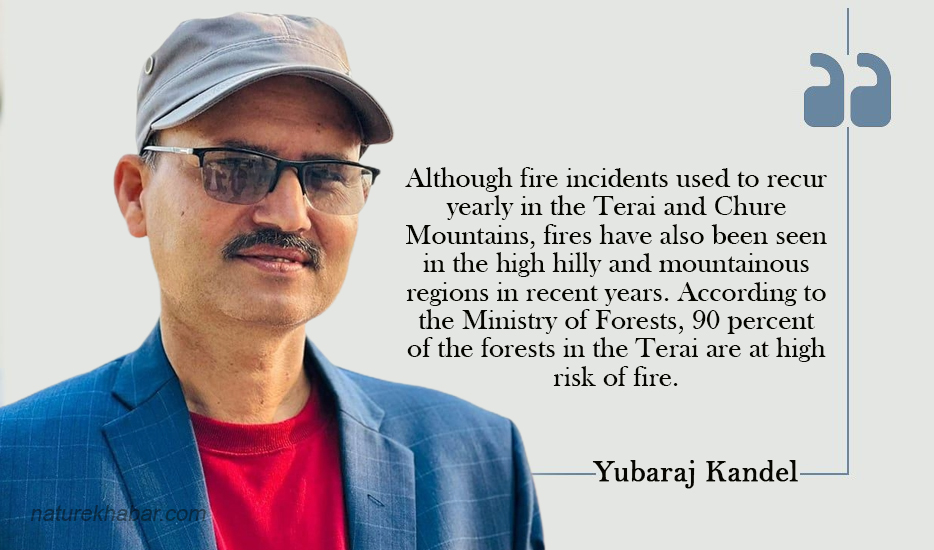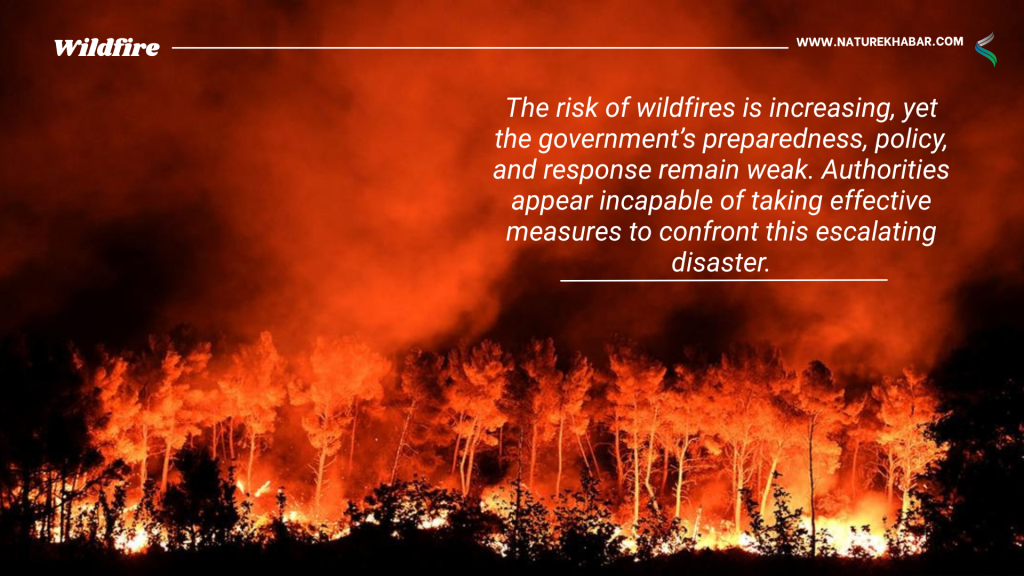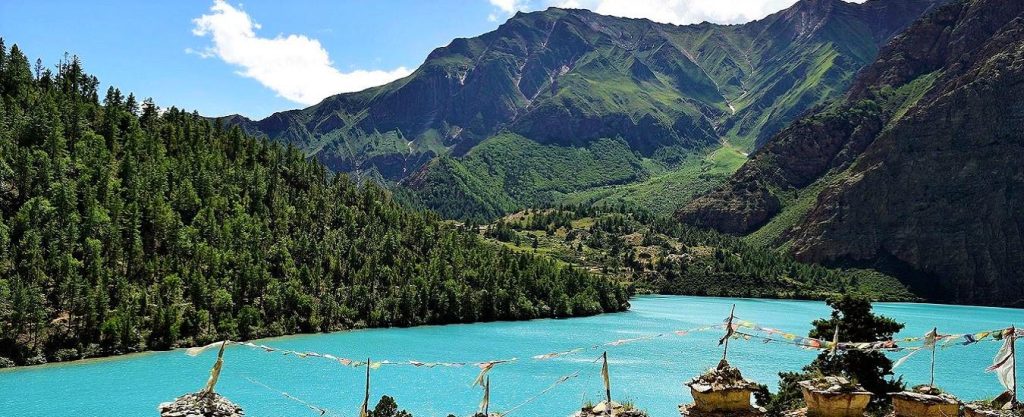The increasing risk of Wildfires and our preparedness
- Nature Khabar

- Yubaraj Kandel
Every year, forest fires occur in Nepal during the summer. But this year, there are reports of severe fires in the hilly and mountainous regions in January. According to the forest fire identification and monitoring system under the Ministry of Forests, fires have broken out in 200 places in the hilly and mountainous regions of the country since the first week of January alone.
Although fire incidents used to recur yearly in the Terai and Chure Mountains, fires have also been seen in the high hilly and mountainous regions in recent years. According to the Ministry of Forests, 90 percent of the forests in the Terai are at high risk of fire.
The coniferous and deciduous forests in the mountainous regions have been continuously affected by fires in recent years. Since there has been no rain in Nepal after winter of this year, except for sporadic rains, the forest area is likely to be drier, and more fires will occur than last year.
Most fires are started by human greed and negligence. According to the Global Fire Monitoring Center, 58 percent of fires in Nepal are caused by deliberate or selfish motives, 22 percent by negligence, and 20 percent by accidents or natural causes. A lack of awareness and ignorance about forests causes fires in Nepal. Fires are set to create a barrier to hunting wild animals, to dry trees for firewood, and to destroy evidence of deforestation. People deliberately set fires in the forest, believing that new grass will grow well in the burned area and that mushrooms and herbs will be produced better.
Some people set fires to remove weeds from their fields, clear their fields, and encroach on the forest, but they are often uncontrolled and turn into large fires. When smokers throw cigarette butts into the forest without extinguishing them, and when they leave the fire after a forest feast without extinguishing it, the fire ignites in the grass and wood. It takes the form of a forest fire. Nowadays, the forests near Nepal's cities and urban settlements are becoming undeclared dumping sites. The garbage thrown into the forest contains highly flammable materials such as plastic, paper, and cloth.
Such materials burn and even self-ignite when a spark falls on them. The more garbage is spread in the forest, the more the fire increases, and since the fire that burns in the trash does not go out for a long time, the risk of forest fires recurring is high. Sometimes, fires also start accidentally. Natural causes, such as lightning strikes, friction between dry trees and stones hitting each other, electrical short circuits or sparks in electric transmission lines running through the forest, and sparks from fire igniting undergrowth, are likely to cause fires in forests with dense and dry trees, but the incidence of such causes is negligible in Nepal.
Due to fires, new plants cannot grow, old plants dry up, and the ground becomes dry, so new plants cannot grow. When the process is repeated for a few years, the forest becomes desolate, and desertification begins in the forest. When wildfires occur, wild animals' habitats and grazing areas are destroyed. Not only are animals unable to escape from fires, but when fires occur, even growing animals burn to ashes along with their bodies and habitats.
Fires are considered a significant factor in the greenhouse effect. Fires release large amounts of carbon dioxide gas, contributing to global warming. Due to fires, watersheds are drying up, and drinking water problems are also arising in some hilly areas of Nepal.
Every year, thousands of hectares of forest are destroyed by fires in Nepal, and government and non-government agencies related to forest conservation are seen struggling to control the fires. After a forest fire breaks out, public awareness programs, seminars, lectures, and rallies are held to prevent fires. Such programs that started after a forest fire have become a money-making game. Although the Forest Act, 2076 BS, and the National Parks and Wildlife Conservation Act, 2029 BS have made it a legal offense to set fire to forests or engage in activities that may cause fire and have provisions for imprisonment and fines; forest fires have not been brought under control due to the vastness of the forest area, lack of resources, and negligence of the general public.
Fire management issues are not adequately addressed in the action plans for community forests, government-managed forests, contractual forests, and protected areas, and even when they are arranged, they have not been implemented effectively.
The failure to control fires despite spending millions of rupees yearly. It indicates a flaw in the policy arrangements and practices related to fires. Due to global warming, the risk of wildfires is increasing every year with growing hot days. The lack of integrated and practical efforts to control wildfires has led to an increase in the number of significant losses due to wildfires.
The government of Nepal has also implemented the Wildfire Control Strategy 2067 to control wildfires effectively. This strategy aims to minimize the damage to people, property, forests, biodiversity, and ecosystems caused by wildfires and to support forest productivity through proper management.
The wildfire management strategy outlines that effective wildfire management can be achieved without the need for large-scale conferences, extensive publicity, or thorough research. There are two key components to successful fire management: controlling potential fire conditions and minimizing damage. The primary goal of fire management is to prevent fires from occurring in the first place. This can be accomplished by implementing measures such as prohibiting garbage disposal in forests and preventing the lighting of fires near forested areas.
Despite taking these precautions, there is always a risk of fire. In such cases, it is essential to focus on preventing the fire from spreading within the forest. For instance, during winter, fallen leaves can create a fire hazard on the forest floor. Regularly clearing weeds, branches, and dry wood before the arrival of summer can help reduce the risk of fire spreading.
In high-risk forest areas, establishing fire control lines before summer starts is advisable to contain potential fires. Additionally, planting evergreen trees in a single line within the forest, known as a "green line," can help prevent fires from spreading. Protecting lakes and ponds in Terai forests, as well as creating water ponds in hilly regions, can also aid in fire control efforts. By implementing these measures before summer begins, the likelihood of wildfires can be significantly reduced. However, once a fire has ignited, it becomes incredibly challenging to contain.
While preventing fires is crucial, a lack of preparation can lead to devastating consequences, including the destruction of valuable property and biodiversity. In Nepal, the issue of fire control is often only addressed after a forest fire has occurred, with little attention paid to potential risks at other times. It is imperative to remain vigilant, as fires can break out in any forest. Residents living near forested areas are particularly vulnerable to the impact of fires, highlighting the importance of proactive measures to mitigate risk.
Local communities must take the initiative to implement preventative fire control measures rather than relying solely on government intervention. By working together and prioritizing fire prevention strategies, we can safeguard our forests and protect our environment for future generations.
yrkandel@gmail.com





Feedback